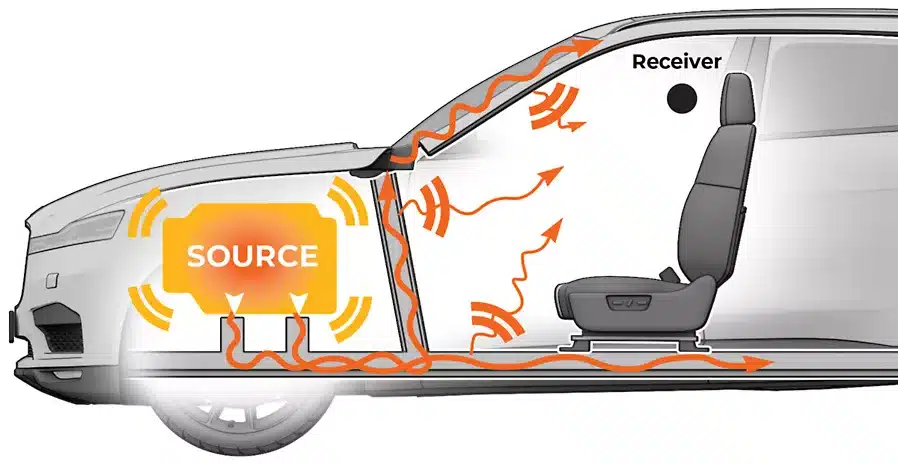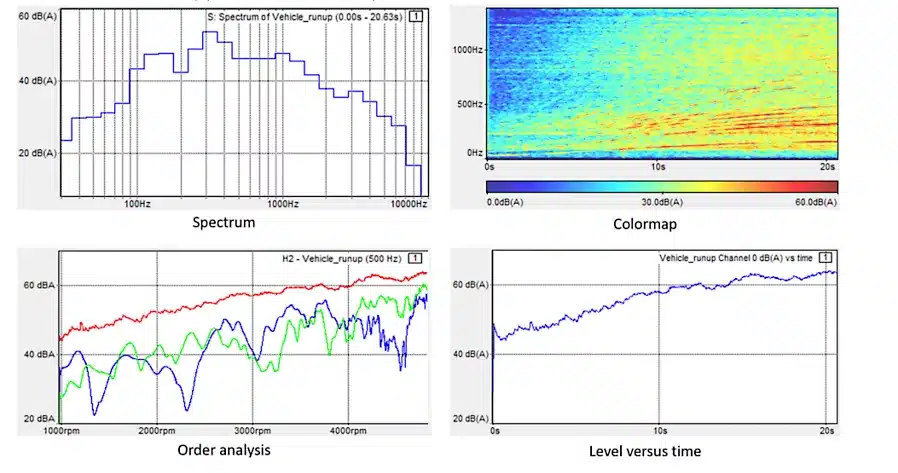Ansys Sound: Acoustic Analysis and Sound Design
Ansys Sound enables you to listen to, analyze and design sound sources based on real acoustics measurements or acoustic simulation results (CAE NVH). The solution offers an innovative post-processing tool to predict and assess noise and vibration via human hearing, from the earliest stages of virtual product modeling or based on a given measurements database. It is able to link sound to driving simulators, flight simulators and virtual reality platforms. Ansys Sound paves the way to target sound definition, brand sound creation, subjective and objective measurement, component separation, and troubleshooting.

Active Sound Design for Electric Vehicles (EV)
Electric vehicle (EV) and autonomous vehicle (AV) manufacturers create signature sounds for their cars (including engine noise) to enhance vehicle appeal and give listeners a feel for the speed and acceleration. Using cutting-edge sound enhancement techniques, automakers are introducing new, customized sounds for their vehicles. These techniques augment natural vehicle sounds by playing synthesized sounds synchronized with the vehicle’s real-time data over the vehicle’s speakers. Ansys delivers in-vehicle sound design and tuning that is designed to predict, test and validate the future soundscape of vehicles in real-world driving conditions, to ensure that EVs provide the optimal sound experience.
E-Motor Noise, Vibration and Harshness (NVH)
Simulating the noise, vibration and harshness (NVH) of an electric motor is important for proper electromagnetic (EM) and vibro-acoustic design of electric vehicles (EVs). Ansys’ solutions can characterize the NVH effects of an electric motor early and accurately in the design cycle to improve vehicle performance and safety. These solutions lower development costs and help support electric mobility (e-mobility) — an application resulting from electrifying transportation. Ansys’ solutions enable EV carmakers or other e-motor integrators to optimize the sound perception and performance, improve customer satisfaction and gain competitive advantage in the transportation and industrial sectors.
How can Simulation Reduce Automotive Noise?
Aeroacoustics simulation helps predict the combined impact of noise sources on the overall sound level in specified locations — for instance, the driver’s seat. Being able to predict noise enables designers to make modifications on car details (e.g., side mirror shape, some door gaps, vents, etc.) and materials to comply with regulations and improve the comfort of the passengers.
Ansys Fluent can solve complex aeroacoustics problems and provide an extensive set of modeling options and post-processing capabilities to improve acoustic design using a variety of methods:
- Broadband noise methods, where the steady solution is used as basis for noise source estimation.
- Acoustic analogy methods, where the computational fluid dynamics (CFD) solution is decoupled from the sound propagation via wave equation solutions.
- Direct methods (i.e., direct computational aeroacoustics), which fully couple the calculation of unsteady flow and acoustic fields.
In the latest Ansys software release, 2022 R1, Ansys has introduced a new acoustics workflow that couples Ansys Fluent CFD simulations to Ansys Sound. This enables engineers to use advanced acoustics analysis techniques to analyze the acoustic pressure signals computed by CFD, including:
- Sound files that let you listen to simulated sounds.
- Reports on volume, tonality, sharpness, and articulation.
- Translation of pressure signals to see acoustic indicators by location.
- Multiple frequency functions for sound composition.


How to Listen to an Acoustic Simulation
Let’s say you want to assess the noise of an electric vehicle. The major components of the powertrain that contribute to the product’s sound are the motor and gearbox. So, to assess the sounds you first use multiphysics workflows that simulate these systems.
The motor electromagnetics can be simulated using Ansys Maxwell and Ansys Mechanical while the gearbox motion can be simulated using Ansys Motion. The information from these models can then be sent to Ansys Sound so engineers can listen to the product. From there, they use these simulations to tweak the design’s performance and its sounds.
As the engineers learn more about their designs, they can expand the simulation to dig into the sound sources from the electric motor itself. This multiphysics workflow could include the structural analysis of static loads, electromagnetic forces, vibration analysis and acoustic noise radiation.

Predict and Assess Noise and Vibration at the Earliest Stages Through Virtual Product Modeling
Sound Analysis, Management and Playback
Perform temporal, spectral and time-frequency graphical analysis of sound and induce modifications on the signal.
Enable the filtering and comparison of sound signals and separate the signals into several components based on state-of-the-art algorithms that capture de-noising, tonal components, transient parts extraction and the mixing of all components. It is possible to track and isolate whistling, whine and any other pure or harmonic frequency. Shocks, ticks, clicks, explosions and every kind of impulsive sounds can be isolated using the transient detection component of the sound module within Ansys Sound.
Harmonic Exploration and E-Motor Sound Analysis
Work with sounds and signals exhibiting harmonic content and employ tools related to orders of rotating machines.
Explore the possibilities of detection or association of an RPM profile to a signal and calculation of order analysis. The RPM signal can be derived from a recorded tachometric signal or pulse signal. Or, extract and create using the integrated tools within Ansys Sound for harmonics detection in the time frequency representation. The power of these tools doesn’t require a specific sensor device, such as a rev counter, to carry out harmonic order analysis; for E-Motor you can also isolate with few clicks, the PWM (pulse width modulation) tones.
Sound of Multiphysics Simulation Results
Listen to Ansys Mechanical, Ansys Fluent, Ansys LS-DYNA and Ansys Motion simulations calculation results and create sound from spectra or waterfall resulting from mechanic, aerodynamic or fluid simulations.
You can listen to the sound from the acoustic simulation of an electric motor dynamic model and then modify sounds to evaluate effects of level changes on components, all while running a study on sound quality.
Psychoacoustics and Sound Quality
Multiple psychoacoustics criteria are monitored—often required for initial qualification of sound quality— and advanced measurements of these metrics are recorded for listening tests.
Joint research involving teams from Ansys and the CNRS LMA research laboratory are used for quantifying impulsive sounds’ loudness. The psychoacoustic feature of Ansys Sound can perform the equalization of a set of signals to reach a specific common indicator, for loudness equalization.
Listening Tests for Sound Perception Measurement
Evaluate the sound quality of your product with Ansys Sound, by measuring sound perception through jury testing experiments.
Immersive Driving Simulator Sound
All sound sources get managed and accurately modeled and configured in the included interactive sound generator for driving simulators.
This includes powertrain (ICE, Hybrid or EV), aerodynamic noise, rolling noise, screeching tires, HVAC, traffic and more, offering an advanced real-time audio synthesis tool for a generation of car-related sounds. Sound is designed to integrate into driving simulators and virtual reality platforms. With an open database, customized car sounds can be created and integrated into the software. The software’s synthesis technique consists of generating sound sources according to real-time events within a given scenario, so when the driving conditions change, the synthesis algorithms match the new conditions, and each sound source evolves accordingly. With the loudspeaker set up to match the customer’s facilities and on-site calibration and equalization, achieve optimal realism.
Engine Sound Enhancement and Active Sound Design
Ansys Sound provides the Active Sound Design (ASD) comprehensive solution for engine sound enhancement (ESE) for electric vehicles (EVs) and internal combustion engine (ICE) cars.
Active Sound Design technologies can create an atmosphere to make the vehicle more alive, more attractive and safer thanks to audio feedback while driving. This is used for ICE engine cars and EV, including AVAS and ADAS sound.
WE WORK WITH YOU
We pride ourselves on empowering each client to overcome the challenges of their most demanding projects.
Enteknograte offers a Virtual Engineering approach with FEA tools such as MSC Softwrae(Simufact, Digimat, Nastran, MSC APEX, Actran Acoustic solver), ABAQUS, Ansys, and LS-Dyna, encompassing the accurate prediction of in-service loads, the performance evaluation, and the integrity assessment including the influence of manufacturing the components.
Aerospace Engineering: AeroAcoustics and VibroAcoustics Simulation
AeroAcoustics and VibroAcoustics in Automotive Industry
NVH & Acoustics for Hybrid & Electric Vehicles
Structural Dynamics Integrity & Vibro-Acoustics Simulation for Marine & Shipbuilding Industry
Audio Device Design: Acoustic simulation for Sound Quality Analysis in Consumer Electronic Devices
NVH ( Noise, Vibration, and Harshness ) simulation services
Finite Element Analysis of Durability and Fatigue Life
Vibration Fatigue Finite Element Simulation: Time & Frequency Domain
Hydrodynamics & HydroAcoustics simulation for AIV (Acoustic Induced Vibration)
Cavitation in Propulsion Systems
Multibody Dynamics & NVH (Noise, vibration, and harshness)
Noise, Vibration & Harshness – NVH for Electric Motors
Hydrodynamics CFD simulation, Coupled with FEA for FSI Analysis of Marine and offshore structures
Integrated Artificial Intelligence (AI) & Machine Learning - Deep Learning with CFD & FEA Simulation
Seat Design: Finite Element and CFD Simulation for Static & Dynamic Comfort, Whiplash, Acoustic & Thermal Comfort, Crash Test
1D/3D Coupled Simulation and Co-Simulation: Detailed Chemistry & Multiphase Flow Modeling with 1D Modeling
Aerodynamics Simulation: Coupling CFD with MBD, FEA and 1D-System Simulation
eVTOL (Electric Vertical Take-Off and Landing) & UAM (Urban Air Mobility)
Full Vehicle MultiBody Dynamics Simulation: Car Ride, Driveline, Engine and Tire MBD
Robots Dynamics & Performance Assessment: Coupled MBD & FEA Simulation-Based Design
Heat Transfer and Thermal Analysis: Fluid-Structure Interaction with Coupled CFD and Finite Element Based Simulation
Aerodynamic Noise Simulation
Acoustics and Vibration: FEA and CFD for AeroAcoustics, VibroAcoustics and NVH Analysis
Electromagnetic Multiphysics




